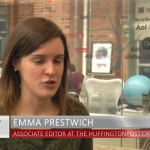Snapchat: From the home to the newsroom
In the second of RRJ's two-part series on "Journalism via Snapchat," Carine Abouseif looks at how Canadian journalists are using the app to create news stories
The little ghosts of Snapchat have been taking over my Twitter feed this last month.
We’ve talked about how Snapchat is being used for a kind of citizen journalism. But not much has been said about how professional journalists and news outlets are using the app—at least not in Canada.
These little white ghosts on my Twitter feed have replaced the logos of news outlets like Huffington Post Canada and CBC Toronto, promoting their Snapchat coverage on Twitter.
Despite the publicity these organizations have given to their Snapchat accounts, they seem to still be experimenting with the tool, and each one of them seems to be using it a little differently.
The Toronto Star, for example, seems to be doing more basic coverage, like snaps of their front cover or notes about the weather.
Screenshots from the Toronto Star’s Snapchat on October 28.
On the other hand, Global News has taken to posting their headlines in a lighthearted style. Instead of images, they use more emojis. They also ask direct followers to go to their website for more on a specific story.
Screenshots from Global News’ Snapchat on October 28.
Still, more dramatically different are the posts Canadian Press reporter David Friend used to cover the Toronto International Film Festival (TIFF). The coverage was much more personal and more in the style of something you would see on a video blog. Most of the snaps involve Friend talking to the camera about his day at TIFF, creating a relationship between Friend and the viewers that is not the stiff one of reporter to audience. For example, throughout the coverage, Friend mentions that he’s not interested in certain parties or that he was hardly able to keep his eyes open on the last day.
CBC Toronto is another outlet that’s been experimenting with Snapchat. Associate producer Nicole Brockbank says that one way they’ve used Snapchat is to cover Blue Jays games. A reporter went to the game and took videos and pictures of big moments. The reporter also used Snapchat to take casual streeters of people at the game. In that way, Snapchat seems to be useful for providing the experience of a specific moment or mood that the audience isn’t there to see. In fact, Huffington Post Canada covered a Raptors game the very same way.
Brockbank says that the CBC Toronto digital team is trying out the medium in different ways, but that ultimately, whatever reporters do with Snapchat, they would likely use it to stitch a narrative together.
It’s clear that Canadian media is toying with Snapchat, but it’s still unclear how big of a role it will play in future coverage. Brockbank says that she sees potential in using Snapchat to cover news in the field at some point in the future. The reporter would be on scene, take a couple of shots and provide an update on camera. But as always, time would be a factor. Would a reporter have time to cover a scene with all the existing methods as well as Snapchat?
So far, Snapchat doesn’t seem to be a place to cover every type of story, but the stories that do get covered there are being presented in a different context that’s often more lighthearted, personal and about the moment.
Related Posts
Carine is the senior online editor of the spring 2016 issue of the Ryerson Review of Journalism.























































